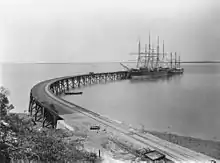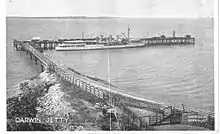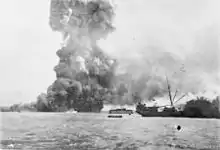Stokes Hill Wharf
Stokes Hill Wharf is the main wharf for the city of Darwin in the Northern Territory of Australia and is named after Stokes Hill, which it sits beside. The hill itself was named after the previous commander of HMS Beagle, Captain Pringle Stokes, by the current commander of the Beagle, John Clements Wickham in 1839.

History

Larrakia Sacred Site
Larrakia were the first people to live in this area and believe “Stokes Hill” to have a Larrakia spiritual ancestor living inside it. This ancestor is known as “Chinute Chinute” and is said to manifest itself from time to time as a tawny frogmouth. The hill is a registered sacred site, and is protected by Larrakia traditional owners of the Greater Darwin Region, with the assistance of the Aboriginal Area Protection Authority. No development, ground disturbing activities, or work is to take place within the sacred site boundaries.[1]
First wharf
The first wharf built in 1885-86 was called the Port Darwin Jetty or Railway Jetty and was made of timber. The railway connecting Palmerston, the previous name for Darwin, to Pine Creek ran onto the wharf. A small steam engine, known as the "Sandfly", was used to shunt rail stock the length of the jetty. The jetty was closed in 1897 owing to the danger of collapse. The cyclone of 1897 and being eaten away by teredo navalis, a salt water clam also known as the naval shipworm, eventually caused the jetty to collapse that year.[2]
Second wharf


The second wharf was built in 1903 and was called the Town Wharf. This was made of cast iron and concrete piers with wooden decking on top. It was built in the shape of an L which caused problems with loading and unloading as railway carts had to be turned on a turntable. In 1922, a rail track along the bridge section was replaced by a cattle race to facilitate live exports. During the 1930s, a small side jetty was built and used as a flying boat terminal. This wharf was damaged in the first Japanese bombing raid on the 19 February 1942 and part of the bridge section was destroyed. Army engineers built a temporary bridge to enable loading to continue.
Third wharf
The third wharf, which is the current wharf, was built and completed in 1956 and was the main wharf for Darwin until the Darwin Port at East Arm was completed in 2000. This wharf was built of steel and concrete with timber decking. The wharf is mainly used as a venue for restaurants and for small boats to tie up alongside.
The wharf was used in 2008 for the filming of the movie Australia, with a bus used to ferry tourists past the filming.[3]
In 2015, the wharf was used for the final stage of a reenactment of Australian Victorian Cross recipient Albert Borella's journey from Tennant Creek to Darwin en route to enlist in World War I.[4]
References
- http://www.waterfront.nt.gov.au/darwin-waterfront-precinct/history/larrakia-sacred-site-stokes-hill/
- "Stokes Hill Wharf". Darwin Waterfront Precinct. Northern Territory Government. Retrieved 26 June 2016.
- "Australia moves to Darwin". Australian Broadcasting Corporation.
- "About the Borella Ride". The Borella Ride. Northern Territory Government. Retrieved 26 June 2016.
External links
 Media related to Stokes Hill Wharf at Wikimedia Commons
Media related to Stokes Hill Wharf at Wikimedia Commons- Stokes Hill Wharf on Darwin Waterfront Precinct Website
